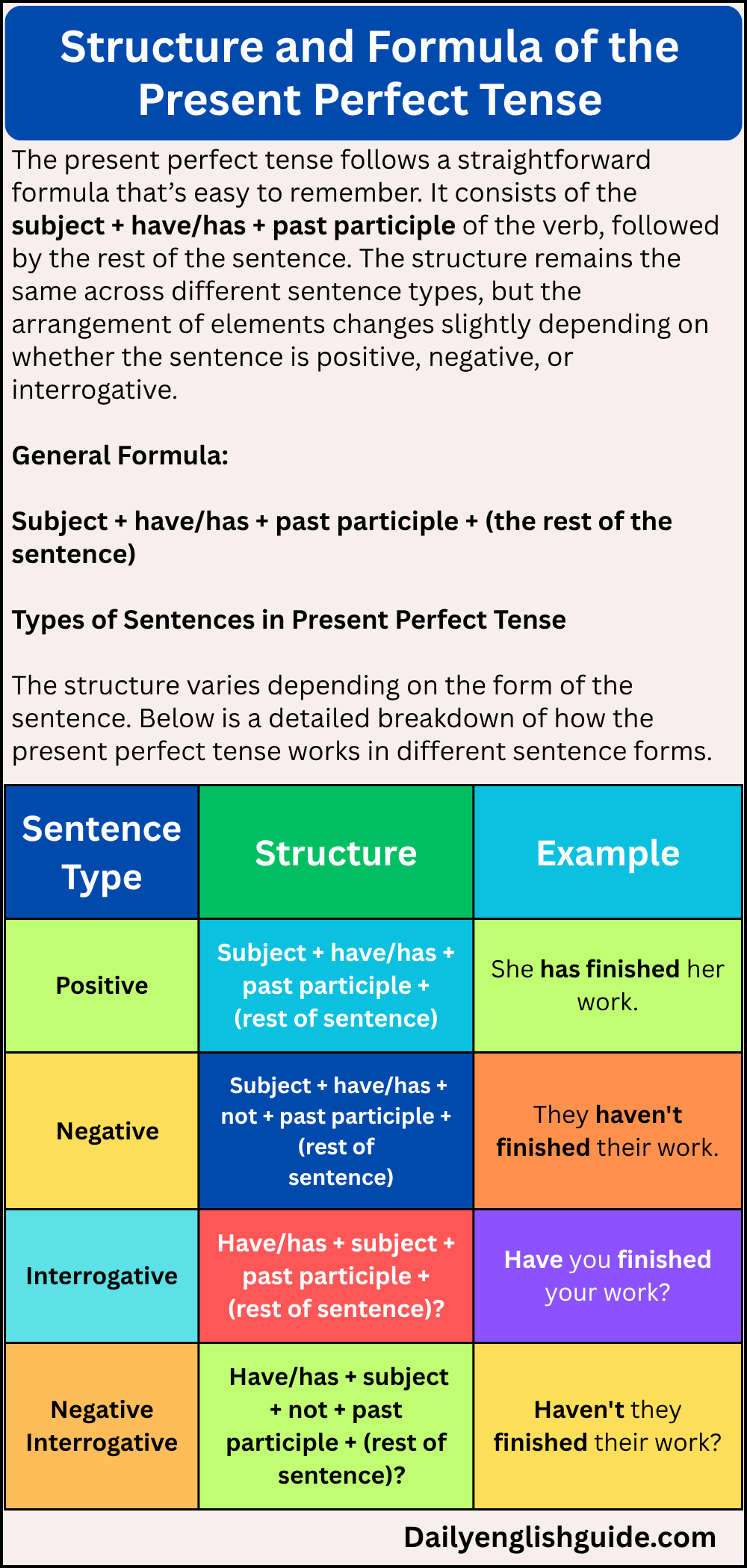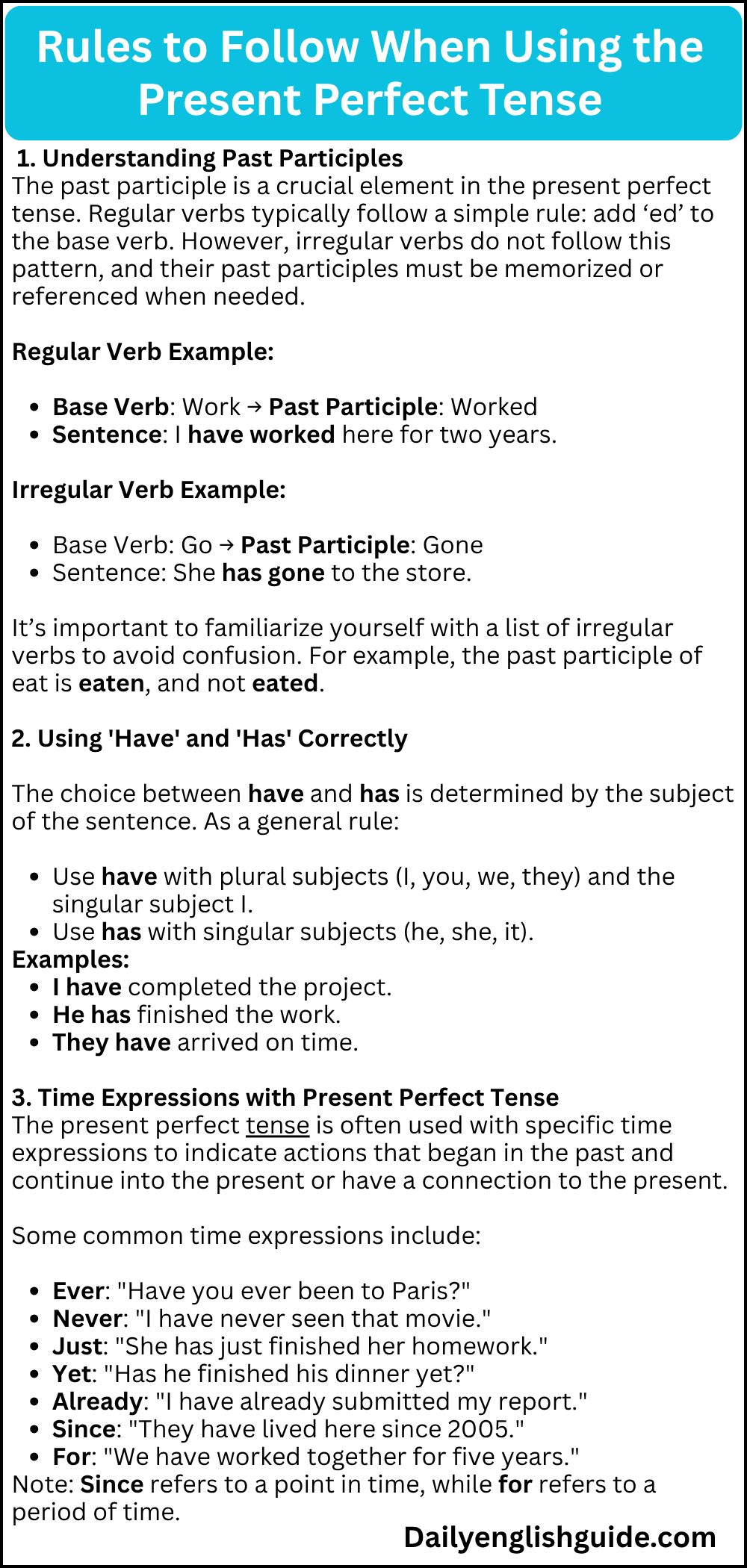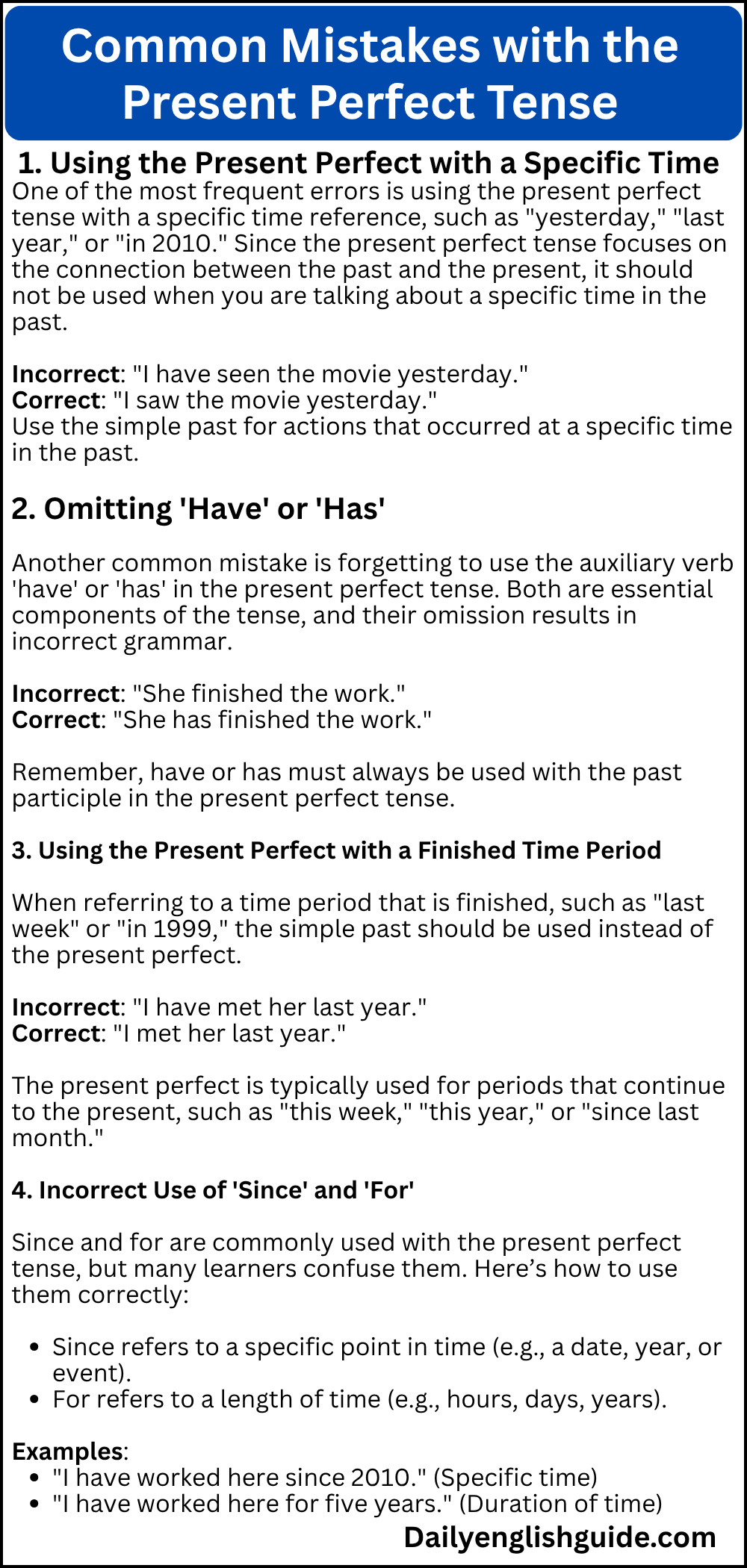The present perfect tense is often misunderstood, but once you grasp its usage and structure, it becomes a valuable tool in both speaking and writing. This tense bridges the past and the present, allowing you to describe actions or events that began in the past and have relevance to the present moment. Whether you’re a student learning English, a professional honing your writing, or a general reader, understanding the present perfect tense can significantly improve your communication.
In this article, we will break down the meaning, structure, uses, and common rules associated with the present perfect tense. By the end of this article, you’ll not only be familiar with how the present perfect tense functions but also understand its nuances in real-world usage.
What is the Present Perfect Tense?
At its core, the present perfect tense is used to describe actions or states that have occurred at some point in the past but are still relevant or connected to the present time. It’s particularly useful when you want to emphasize the link between past actions and their present consequences.
The present perfect is formed by using the auxiliary verbs ‘have’ or ‘has’ along with the past participle of the main verb. This tense does not specify the exact time when the action took place, which distinguishes it from other tenses like the past simple.
Key Definitions:
-
Present Perfect Tense: A verb tense used to describe actions that happened at an indefinite time in the past or actions that have a direct impact on the present moment.
-
Past Participle: The third form of a verb, often used in perfect tenses. For regular verbs, it typically ends in ‘ed’, but irregular verbs may have unique forms.
Real-life Examples of the Present Perfect Tense
-
“She has visited London.”
-
“They have eaten lunch.”
-
“I have finished my homework.”
These examples show how the present perfect connects past actions with their relevance to the present. The focus is not on when the action happened but rather on its current relevance or result.

Structure and Formula of the Present Perfect Tense
The present perfect tense follows a straightforward formula that’s easy to remember. It consists of the subject + have/has + past participle of the verb, followed by the rest of the sentence. The structure remains the same across different sentence types, but the arrangement of elements changes slightly depending on whether the sentence is positive, negative, or interrogative.
General Formula:
Subject + have/has + past participle + (the rest of the sentence)
Types of Sentences in Present Perfect Tense
The structure varies depending on the form of the sentence. Below is a detailed breakdown of how the present perfect tense works in different sentence forms.
| Sentence Type | Structure | Example |
|---|---|---|
| Positive | Subject + have/has + past participle + (rest of sentence) | She has finished her work. |
| Negative | Subject + have/has + not + past participle + (rest of sentence) | They haven’t finished their work. |
| Interrogative | Have/has + subject + past participle + (rest of sentence)? | Have you finished your work? |
| Negative Interrogative | Have/has + subject + not + past participle + (rest of sentence)? | Haven’t they finished their work? |
Examples:
Positive Sentences:
-
I have visited the museum.
-
He has finished the book.
-
They have worked together for years.
Negative Sentences:
-
I have not gone to the party.
-
She hasn’t seen the movie yet.
-
We haven’t heard from him.
Interrogative Sentences:
-
Have you met him?
-
Has she completed the assignment?
-
Have they arrived yet?
Negative Interrogative Sentences:
-
Haven’t you seen that movie?
-
Hasn’t he finished his meal?
-
Haven’t they visited that place before?
Important Notes:
-
The auxiliary verb “have” is used with plural subjects (e.g., I, we, they) and “has” is used with singular subjects (e.g., he, she, it).
-
For negative sentences, “not” is inserted between the auxiliary verb and the past participle. Alternatively, contracted forms like haven’t or hasn’t are commonly used in informal contexts.

Rules to Follow When Using the Present Perfect Tense
To use the present perfect tense correctly, it’s essential to understand the rules behind its formation and usage. While the tense itself may seem straightforward, certain key points need to be kept in mind to ensure accurate and effective communication. These rules cover past participles, the use of auxiliary verbs, and common exceptions in usage.
1. Understanding Past Participles
The past participle is a crucial element in the present perfect tense. Regular verbs typically follow a simple rule: add ‘ed’ to the base verb. However, irregular verbs do not follow this pattern, and their past participles must be memorized or referenced when needed.
Regular Verb Example:
-
Base Verb: Work → Past Participle: Worked
-
Sentence: I have worked here for two years.
Irregular Verb Example:
-
Base Verb: Go → Past Participle: Gone
-
Sentence: She has gone to the store.
It’s important to familiarize yourself with a list of irregular verbs to avoid confusion. For example, the past participle of eat is eaten, and not eated.
2. Using ‘Have’ and ‘Has’ Correctly
The choice between have and has is determined by the subject of the sentence. As a general rule:
-
Use have with plural subjects (I, you, we, they) and the singular subject I.
-
Use has with singular subjects (he, she, it).
Examples:
-
I have completed the project.
-
He has finished the work.
-
They have arrived on time.
3. Time Expressions with Present Perfect Tense
The present perfect tense is often used with specific time expressions to indicate actions that began in the past and continue into the present or have a connection to the present.
Some common time expressions include:
-
Ever: “Have you ever been to Paris?”
-
Never: “I have never seen that movie.”
-
Just: “She has just finished her homework.”
-
Yet: “Has he finished his dinner yet?”
-
Already: “I have already submitted my report.”
-
Since: “They have lived here since 2005.”
-
For: “We have worked together for five years.”
Note: Since refers to a point in time, while for refers to a period of time.
4. When Not to Use Present Perfect Tense
While the present perfect tense is versatile, there are situations where other tenses are preferred. The present perfect tense is not typically used when the exact time of the action is important. In those cases, the simple past tense is preferred. For example:
-
Present Perfect: “I have seen that movie.”
-
Simple Past: “I saw that movie yesterday.”
The simple past is used when the action happened at a definite time in the past.
5. Expressing Life Experiences
The present perfect tense is often used to talk about life experiences. This is particularly useful when you want to discuss actions that have happened at some indefinite point in your life without mentioning when they occurred.
Example: “I have traveled to many countries.”
Uses of the Present Perfect Tense
The present perfect tense serves several essential functions in both spoken and written English. By understanding its different uses, you’ll be able to incorporate this tense seamlessly into your daily communication. Below, we highlight the most common uses of the present perfect tense, with examples to clarify each situation.
1. To Express Actions that Have an Impact on the Present
One of the primary uses of the present perfect tense is to describe actions that were completed in the past but have ongoing relevance or consequences in the present. In these cases, the focus is on the result of the action rather than the action itself.
Examples:
-
“She has lost her keys” (She cannot find them now).
-
“They have finished their project” (The project is now complete).
The present perfect helps show that the effects of the action are still relevant now, even if the action itself occurred in the past.
2. To Indicate Actions that Started in the Past and Continue to the Present
The present perfect is also used to express actions or situations that began in the past and are still ongoing at the time of speaking. In this context, the verb “have/has” is often used with time expressions like since and for.
Examples:
-
“I have lived here for five years.”
-
“She has worked at the company since 2010.”
In these sentences, the actions started in the past and are still true or relevant in the present.
3. To Talk About Life Experiences
Another common use of the present perfect tense is to discuss experiences or accomplishments without specifying exactly when they occurred. This can include both positive and negative experiences.
Examples:
-
“I have seen that movie before.”
-
“She has never traveled to Europe.”
The exact time of the event is unimportant in these sentences, and instead, the focus is on the experience itself.
4. To Describe Recent Actions or Events with a Connection to the Present
Sometimes, the present perfect tense is used to describe actions that happened very recently but still have an impact or connection to the present moment. This is often accompanied by words like just or already.
Examples:
-
“I have just finished my lunch.”
-
“He has already left the office.”
These sentences imply that the actions happened shortly before now and have relevance at the current moment.
5. To Talk About Changes Over Time
The present perfect tense can be used to highlight changes or developments that have occurred over a period of time, especially when the change is still relevant to the present.
Examples:
-
“Technology has improved greatly in the last decade.”
-
“Her English has gotten much better.”
This usage emphasizes that the action (or change) is ongoing and has a lasting effect.

Common Mistakes with the Present Perfect Tense
Despite its simple structure, many learners of English make mistakes when using the present perfect tense. These errors often arise due to confusion with other tenses, the misuse of auxiliary verbs, or misunderstanding when to apply the tense. Below, we’ve listed some of the most common mistakes and how to avoid them.
1. Using the Present Perfect with a Specific Time
One of the most frequent errors is using the present perfect tense with a specific time reference, such as “yesterday,” “last year,” or “in 2010.” Since the present perfect tense focuses on the connection between the past and the present, it should not be used when you are talking about a specific time in the past.
Incorrect: “I have seen the movie yesterday.”
Correct: “I saw the movie yesterday.”
Use the simple past for actions that occurred at a specific time in the past.
2. Omitting ‘Have’ or ‘Has’
Another common mistake is forgetting to use the auxiliary verb ‘have’ or ‘has’ in the present perfect tense. Both are essential components of the tense, and their omission results in incorrect grammar.
Incorrect: “She finished the work.”
Correct: “She has finished the work.”
Remember, have or has must always be used with the past participle in the present perfect tense.
3. Using the Present Perfect with a Finished Time Period
When referring to a time period that is finished, such as “last week” or “in 1999,” the simple past should be used instead of the present perfect.
Incorrect: “I have met her last year.”
Correct: “I met her last year.”
The present perfect is typically used for periods that continue to the present, such as “this week,” “this year,” or “since last month.”
4. Incorrect Use of ‘Since’ and ‘For’
Since and for are commonly used with the present perfect tense, but many learners confuse them. Here’s how to use them correctly:
-
Since refers to a specific point in time (e.g., a date, year, or event).
-
For refers to a length of time (e.g., hours, days, years).
Examples:
-
“I have worked here since 2010.” (Specific time)
-
“I have worked here for five years.” (Duration of time)
5. Misuse of Irregular Past Participles
As mentioned earlier, irregular verbs do not follow the typical -ed pattern in the past participle. It’s essential to learn the correct form of irregular verbs to avoid errors in tense formation.
Incorrect: “I have writed a letter.”
Correct: “I have written a letter.”
If in doubt, consult a list of irregular verbs to ensure correct usage.
Conclusion
Mastering the present perfect tense is a crucial step in becoming fluent in English. This tense allows you to link past actions to the present, express ongoing situations, and share experiences in a natural and cohesive way. By following the rules outlined above, avoiding common mistakes, and practicing regularly, you’ll gain confidence in using the present perfect tense accurately and effectively.
